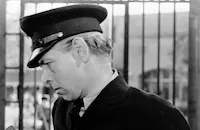Cleopatra

Brief Synopsis
Cast & Crew
Cecil B. Demille
Claudette Colbert
Warren William
Henry Wilcoxon
Joseph Schildkraut
Ian Keith
Film Details
Technical Specs

Synopsis
In 48 B.C., Egyptian Prime Minister Pothinos kidnaps Queen Cleopatra and her philosopher, Apollodorus, and leaves them in the desert, warning Cleopatra that he will have her killed if she returns to Egypt. Realizing her brother Ptolemy could weaken and serve under Roman rule, Cleopatra and Apollodorus make their way to Caesar's camp, and she cleverly gains an audience with Julius Caesar. Cleopatra reveals Pothinos' treachery and tempts Caesar with the possibility of conquering India by going through Egypt. Later, Cleopatra tries to seduce Caesar, and then proves her fidelity to him by killing Pothinos, who had been lying in wait behind some curtains in her chamber. Cleopatra and Caesar fall in love, much to the chagrin of Caesar's followers in Rome, who fear that if Caesar divorces his wife, Calpurnia, and marries Cleopatra, Caesar would become a king, and Rome would no longer be a republic. Caesar brings Cleopatra home to Rome, and soldier Marc Antony urges him not to allow her to make an Egyptian of him. Calpurnia begs Caesar not to speak to the senate, as she has dreamed of his death, but he belittles her vision and is escorted by Casca, who, along with Brutus, Cassius and others, murder him before he reaches the senate. Cleopatra is devastated and returns to Egypt, while the Roman senate rules that Caesar's nephew Octavian will rule Rome jointly with Marc Antony, and Antony will avenge Caesar's death and punish Egypt. Antony arranges a meeting with Cleopatra in a public square, where he hopes to ambush her with his soldiers, but instead she ensnares him in her ship where she tantalizes him with a feast, dancing girls and jewels, gets him drunk and seduces him. Antony returns to Egypt with Cleopatra where they fall in love. Two months later, King Herod warns Cleopatra that Octavian has declared Antony a traitor, and insinuates that her relations with Rome would be improved if Antony were dead. Apollodorus also advises Cleopatra to kill Antony, and she begins to test poisons on convicts. Warned by Herod, Antony hears that Cleopatra is testing poisons, and thus is suspicious when she serves a special meal with wine for him. She allays his fears, and at the moment he is about to drink the poisoned wine, news arrives that Rome has declared war against Egypt. Antony is roused to action and tells Cleopatra that she can either choose him or Rome. She is impressed by her lover, and after telling him that she is no longer a queen, but a woman, she prevents him from drinking the poisoned wine. Antony calls general Enobarbus to serve with him, but Enobarbus' loyalties are with Rome, and he refuses. Antony raises an army of Egyptian soldiers, and the battle is fought on land and sea. The Egyptian troops suffer defeat, and only Antony survives. Cleopatra secretly goes to Octavian and offers him Egypt in exchange for Antony's life, and he reluctantly accepts the terms. Antony mistakes Cleopatra's willingness to see Octavian as duplicity and commits suicide, but Cleopatra finds him in time to correct him and declare her fidelity to him before he dies. As the gate to the throne of Egypt is smashed by Roman troops, Cleopatra kills herself by the bite of a poisonous asp.

Director

Cecil B. Demille
Cast

Claudette Colbert

Warren William

Henry Wilcoxon

Joseph Schildkraut

Ian Keith
Gertrude Michael

C. Aubrey Smith

Irving Pichel

Arthur Hohl
Edwin Maxwell
Ian Maclaren
Eleanor Phelps

Leonard Mudie
Grace Durkin
Ferdinand Gottschalk

Claudia Dell
Harry Beresford
Jane Regan

William Farnum
Lionel Belmore
Florence Roberts
Dick Alexander
Celia Ryland

William V. Mong

Robert Warwick
George Walsh
Jack Rutherford
Kenneth Gibson
Wedgewood Nowell
Bruce Warren
Robert Manning
Ed Deering
John Rutherford
Charles Morris
Margerie Bonner
Leon Beauman
Colonel Nicholai Kolovaloss
Colonel Tim Lonergan
John Roy Marsilio
Gil Barry
Bob Hall
Carl Saxe
Ernie Smith

Bryant Washburn

Mary Maclaren
Jack Mulhall
Julanne Johnston

Phillips Smalley
Edmund Jones
Inez Seabury

Wilfred Lucas
Bryant Washburn Jr.
Carlyle Blackwell Jr.
Reuben Schaffer
Horace B. Carpenter
Jilda Keeling
Mary Fahrney
Crew
Roland Anderson
Travis Banton
Emily Barye
Anne Bauchens
Roy Burns
Florence Cole
Bartlett Cormack
Cecil B. Demille
Hans Dreier
Nathaniel Finston
Billy Gordon
Franklin Hansen
Gladys Jeans
Ralph Jester
Ray Jones
Rudolph Kopp
Vincent Lawrence
Harry Lindgren
David Macdonald
Jeanie Macpherson
William Mellor
Victor Milner
Gladys Percey
Robert Rhea
Guy Roe
Cooper Smith
Cullen Tate
Waldemar Young
Adolph Zukor

Photo Collections
Videos
Movie Clip




Trailer
Hosted Intro
Film Details
Technical Specs

Award Wins
Best Cinematography
Award Nominations
Best Director
Best Editing
Best Picture
Best Sound
Articles
Cleopatra (1934)
The fabulous costumes that adorned Colbert won raves for designer Travis Banton, although he was not the original costume designer for the film. The scoop is that Banton was called in at the last minute to redesign the entire wardrobe - in one day - because Colbert threatened to walk off the set due to the "unacceptable" gowns made for her by DeMille's staff at Paramount. According to publicity released by the studio, Banton produced "one of the most extravagant wardrobes seen on the screen on a day-to-day basis."
Although Colbert made a stunning Queen of Egypt in her new attire, problems plagued the shoot. Colbert contracted health problems stemming from an attack of appendicitis from the jungle shoot for her previous film, Four Frightened People (1934), and her illness forced her stand-in to rehearse her scenes, as Colbert could only stand for minutes at a time, often collapsing from pain. The elaborate clothing just exacerbated the problems; temperatures were kept low for scenes that included a costume with feathers, so as to prevent molting. Another outfit featured a veil that weighed seventy-three pounds.
After overcoming her illness, Colbert faced another threat - her fear of snakes. DeMille, knowing of his leading lady's phobia, put off filming the death of the Queen of the Nile until the last possible moment. He entered the set with a boa constrictor wrapped around his neck - and then handed Colbert a tiny garden snake. The small reptile produced more pity than fear from his amused star.
Cleopatra was a box office success and garnered five Academy Award nominations, including one in a brand-new category: film editing. The film won an Oscar for Best Cinematography.
Producer/Director: Cecil B. DeMille
Screenplay: Bartlett Cormack, Vincent Lawrence, Waldemar Young
Cinematography: Victor Milner
Costume Design: Travis Banton
Film Editing: Anne Bauchens
Original Music: Rudolph G. Kopp
Principal Cast: Claudette Colbert (Cleopatra), Warren William (Julius Caesar), Henry Wilcoxon (Marc Antony), Gertrude Michael (Calpurnia), Joseph Schildkraut (King Herod), Ian Keith (Octavian), C. Aubrey Smith (Enobarbus), Irving Pichel (Apollodorus).
BW-101m. Closed Captioning.
by Genevieve McGillicuddy

Cleopatra (1934)
Quotes
Together we could conquer the world.- Cleopatra
Nice of you to include me.- Julius Caesar
Trivia
Daily Variety reported that the film was badly panned by Italian critics, one of whom called it a "travesty and a burlesque," when shown in Rome. It also was met with "catcalls and derisive laughter" from the audience.
Notes
According to a news item in Daily Variety, dancer Agnes DeMille, the niece of director Cecil B. DeMille, was cast to perform in the film. In one scene she was supposed to dance on the back of a bull, however, she left the cast due to artistic differences with her uncle. News items in New York Times note that while only two months were spent shooting the film, months were spent on historical research, and duplicates of ancient Roman artifacts were created for realism. According to the pressbook, this was English actor Henry Wilcoxon's first role in an American feature film. The pressbook also notes that DeMille recalled that he cast Wilcoxon as Marc Antony after unintentionally seeing his test film while in a projection booth. Some scenes were filmed on location in the desert near Muroc, CA, and at the sand dunes of El Segundo, CA. According to a contemporary advertisement, Cleopatra was released in Germany, with German dialogue by Helmut Brandis and H. von Lortenbach and German direction by Kurt Blemis.
A 1935 news item in Daily Variety reports that when the film was first shown in Rome, Italy, the audience responded with "catcalls and derisive laughter," and the Italian critics called the picture a "travesty and a burlesque." Victor Milner won an Academy Award for cinematography, and the picture was nominated for the following awards: Best Picture, Sound Recording (Paramount Studio Sound Department, Franklin Hansen, director), Film Editing (Anne Bauchens) and Assistant Director (Cullen Tate). Modern sources include the following cast credits: Olga Celeste (Slavegirl), Ecki (Leopard), John Carradine (Roman), and Hal Price (Onlooker at procession). Other films based on the reign of Cleopatra include Helen Gardner Picture Players' 1912 Cleopatra, directed by Charles L. Gaskill and starring Helen Gardner and Mr. Sindelar; Fox Film Corp.'s 1917 Cleopatra directed by S. Gordon Edwards and starring Theda Bara, Fritz Leiber and Thurston Hall; and Twentieth Century-Fox's 1963 Cleopatra, directed by Joseph L. Mankiewicz and starring Elizabeth Taylor.
















